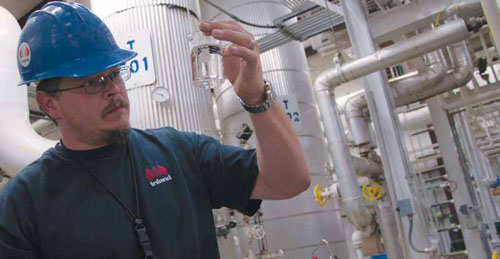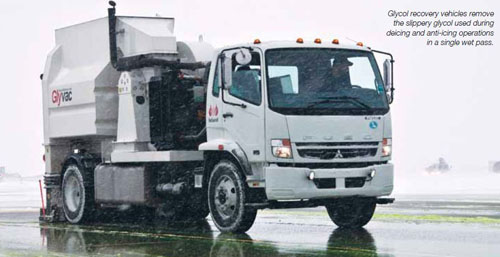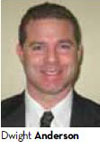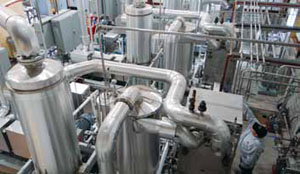Denver Int'l & Portland Jetport Stand Ready for New Glycol Regs

![]() Airports throughout the country are taking stock of their aircraft deicing strategies and wastewater systems as they anticipate new effluent limitation guidelines from the Environmental Protection Agency (EPA) in October. The updated federal standards are expected to require commercial airports to collect a predetermined portion of their dispensed glycol and treat the resulting wastewater on- or off-site.
Airports throughout the country are taking stock of their aircraft deicing strategies and wastewater systems as they anticipate new effluent limitation guidelines from the Environmental Protection Agency (EPA) in October. The updated federal standards are expected to require commercial airports to collect a predetermined portion of their dispensed glycol and treat the resulting wastewater on- or off-site.
|
factsfigures Deicing Fluid Recovery/Recycling Location: Denver Int'l Airport Owner: City and county of Denver Sustainability Technology Evaluation: Parsons Glycol Recycling: Inland Technologies Int'l Background: Officials included a deicing fluid collection & recycling system into plans for Denver Int'l after Stapleton Int'l was sued for industrial storm water permit violations. Recent Upgrades: $1.4 million to add a 4th collection cell Of Note: Airport recaptures 71% of sprayed fluid & recycles 72% of what it collects. |
Denver-Style Deicing
DEN's onsite treatment center - one of the largest glycol recycling systems in the world - helps reinforce DEN's reputation as an environmentally friendly facility. It also saved the airport nearly $2 million in costs during the 2009-2010 deicing season, including $1 million in disposal fees.
 Parsons senior vice president and aviation division manager Ginger Evans was chief engineer for the development of DIA and spearheaded the initiative to built on-site recycling facilities for glycol at the new airport. Working with David Rhodes, the airport's deputy manager of aviation, Evans analyzed the impact glycol recycling has had at DEN since the airport opened in 1995.
Parsons senior vice president and aviation division manager Ginger Evans was chief engineer for the development of DIA and spearheaded the initiative to built on-site recycling facilities for glycol at the new airport. Working with David Rhodes, the airport's deputy manager of aviation, Evans analyzed the impact glycol recycling has had at DEN since the airport opened in 1995.
A white paper issu ed earlier this year chronicles some of their findings:
• DEN has captured at least 69% of the aircraft deicing fluid applied during the last seven deicing seasons.
• During the 2009-10 deicing season, 71% of the nearly 2 million gallons of aircraft deicing fluid sprayed was collected - a rate that significantly exceeded prevailing EPA effluent guidelines.
• 72% of the deicing fluid collected during the 2009-10 season was recycled.
• Facility planning and operational improvements steadily increased the amount of glycol that is captured and treated.
DEN's environmental program administrator, Keith Pass, says the airport's collection rate is recognized as the best in the industry and credits Inland for much of its success.
|
Deicing Fluid Recovery/Recycling Location: Portland (ME) Int'l Jetport Consulting Engineer: Deluca-Hoffman Associates Glycol Recycling: Inland Technologies Int'l Equipment: Modular portable distillation unit Federal Funding: $11 million Of Note: Airport receives per gallon credits from Inland for fluid processed from off-premises locations. |
Learning From History
When DEN was under development, management of spent aircraft deicing fluid was a priority. But before DEN replaced Stapleton International Airport 16 years ago, the Sierra Club sued Denver's Department of Aviation for violations of the airport's industrial storm water permit.
When the lawsuit began, Stapleton, like most airports, was not very involved in aircraft deicing, Evans recalls. "It was something the airlines did out on the ramp," she relates.
But then a couple of tragic aircraft incidents prompted the airlines to step up their deicing activity, and the results eventually showed up in a nearby stream, continues Evans. During heavy precipitation, spent glycol would run into Sand Creek. Although the propylene glycol found in aircraft deicing fluid is biodegradable, it generates a high biochemical oxygen demand during decomposition, depleting oxygen levels in waterways and potentially choking plants and animals.

The Denver Department of Aviation addressed the issue at Stapleton and settled the lawsuit. One of the first steps taken was designating specific ramp areas for deicing. The trickier issue was determining what to do with the more concentrated collection of spent aircraft deicing fluid and wastewater.
Putting the full biological oxygen demand load from the deicing fluid down the sewer all at once caused problems for the local wastewater treatment plant. Evans recalls the Metro Wastewater Reclamation District asking the airport to store the spent deicing fluid and meter it out slowly.
As retention ponds were being built for storage, the airport learned that reclaimed glycol had value. "We got smart and realized there were lots of industrial uses for the recycled product," Evans explains. She likens the glycol in aircraft deicing fluid to aluminum cans: "Some day we will wonder why we threw it away."
Instead of transporting spent aircraft deicing fluid 20 miles away to the wastewater plant and paying to have it treated, the Department of Aviation decided to build a recycling plant at the new airport. The City and County of Denver contracted Aircraft Deicing Services to provide a glycol storage/distribution system and recycling facility at DEN. Inland eventually took over operations of the plant in 2004.
The infrastructure built to keep deicing waste from polluting storm water includes deicing pads, a deicing waste storm water collection/retention system, the West Airfield Diversion System (a system that diverts low-flow storm water runoff away from the clean storm water system and into the deicing waste storm water system), a deicing fluid recycling plant, secondary containment structures and contained material storage and handling areas.
$11 Million Investment Improves Glycol Management at Portland Jetport Federal stimulus funding and Airport Improvement Program grants funded two projects totaling $11 million to help Portland International Jetport meet Maine's requirement for handling spent aircraft deicing fluid. Beginning last November, the airport was up and running with new active holding tanks and Inland was onsite with its Glycol Concentrators. During the first phase, which ended in 2009, Shaw Brothers Construction built the trench drains and preliminary elements of the deicing apron. Phase 2, worth $8 million, increased the size of the concrete apron by 3.2 acres, added a 500,000-gallon underground storage tank for deicing fluid and provided drainage improvements for future airport expansion. Phase 2 also provided the backdrop for Sargent Corporation to win the 2011 Associated General Contractors Build Maine Award for innovative solutions and dedicated teamwork. One of the ideas recognized was a design change suggested by operations vice president Tim Folster. By using a cast-in-place storage tank for deicing fluid rather than interlocking pre-cast tanks with tongue-and-groove fittings, the airport secured a better product without increasing its costs. The award also acknowledged Sargent's success excavating a 500-foot trench within 12 inches of an oil pipeline. To ensure the pipeline wasn't damaged, Sargent backfilled primarily by hand, using small compacting tamps and excavators. Although statistics hadn't been calculated for the system's first season (2010-2011), airport manager Paul Bradbury suspects it achieved its target of 70% recovery.
Collecting & Recycling

Each season, DEN experiences about 66 full days of deicing - and even more morning-only operations. Concrete deicing pads help improve ramp efficiency during extreme weather by freeing gate space for incoming aircraft, explains Evans. Locating the pads close to the departure runway thresholds decreases the time from deicing to take-off, she adds.
The pads have also improved the logistics of deicing operations. Away from the terminal, four trucks can deice a plane more efficiently and effectively than the more limited number of trucks that could maneuver around an airplane parked at a gate. In addition, the move helps keep ramp workers and catering trucks from being exposed to slippery deicing fluid.
DEN has added additional deicing pads since it first opened, for a current total of 28 positions. Spent deicing fluid and storm water runoff that mix on the deicing pads are captured in perimeter trench drain systems, and each pad has a corresponding lined retention pond. If the collected runoff has a glycol concentration of 1% or more, it is directed to the recycling plant for processing. Fluid with less than 1% glycol is sent to a storage area at the airport for subsequent discharge to the Metro Wastewater Reclamation District according to a contribution permit.
Fluids destined for recycling travel via underground pipes to one of seven holding tanks. Six have a capacity of 420,000 gallons each; one 800,000-gallon tank is dedicated to a specific 18-acre deicing pad. The spent deicing fluid is stored until sufficient volume accumulates to begin recycling.
When Inland began operating the facility in 2004, it installed new technology to enhance the glycol recycling process.
"Inland has been very responsive to (our) needs," Pass says. "They have really stepped up to the plate to bring in the equipment so that the airport could continue to grow."
DEN currently has eight of Inland's proprietary Glycol Concentrators, each 6 feet by 20 feet. Six are housed in a 30-foot-by-65-foot building constructed by Inland; two are set up in a temporary tent.
The recycling process has three basic steps: 1) Glycol Concentrators use mechanical vapor recompression to separate excess water from spent aircraft deicing fluid and produce a concentrated glycol/water mixture. 2) The fluid is distilled to 99.5% glycol. 3) The distilled glycol goes through a polishing system to remove trace airfield contaminants.
The resulting glycol product meets standards for industrial-grade propylene glycol, a form used in unsaturated polyester resins, coolants, heat transfer fluids and windshield wash additives.
The revenue generated from the sale of recycled glycol is used to offset environmental program costs related to deicing, reports Rhodes. Inland, he adds, has considerably reduced the facility's operating expenses since it took over in 2004.
Continual Improvement
Last year FAA awarded DEN a $1.4 million grant to increase the operational efficiency and flexibility of its deicing waste collection/retention system. Adding another 7 million-gallon cell to the West Airfield Diversion System's existing three-cell pond will increase its collection capacity to 29.5 million gallons and the airport's overall deicing waste collection capacity to 68.6 million gallons. The new cell is scheduled to be ready for the coming deicing season and is expected to provide the airport with more flexibility to meet the reclamation district's discharge requirements.
 Rhodes says DEN's biggest current challenge is managing traffic at the deicing pads. "Right now, each airline is responsible for deicing their own aircraft," he says, noting that some use airline employees for the job, while others contract an outside vendor.
Rhodes says DEN's biggest current challenge is managing traffic at the deicing pads. "Right now, each airline is responsible for deicing their own aircraft," he says, noting that some use airline employees for the job, while others contract an outside vendor.
Assigning airlines specific spaces on deicing pads isn't practical during full-day deicing because there are times when airlines will have aircraft at different banks at different times, he explains. DEN is consequently considering ways to reorganize operations, possibly by setting up a deicing consortium with a limited number of contractors providing service on a "first come, first served" basis.
"If we can be more efficient in using the pads, we can delay building new pads," Rhodes explains.
Smaller-Scale Solution
With a footprint spanning 53 square miles, finding space on the edge of the ramp for deicing operations was not a challenge at DEN, especially when starting with the "clean slate" of a new airport.
Portland International Jetport (PWM) in Maine does not have the same advantage. It occupies fewer than 700 acres (about one square mile) and handles far fewer enplanements: almost 900,000 compared to more than 25 million at DEN. Despite its smaller size and traffic volume, the airport still needed a solution for managing spent aircraft deicing fluid.
In 2008, the Maine Department of Environmental Protection notified the airport that it needed to have an operational glycol removal/treatment system in place by Nov. 1, 2010. In essence, the state mandated the airport to employ the best available technology and anticipated 70% capture, explains PWM manager Paul Bradbury.
needed to have an operational glycol removal/treatment system in place by Nov. 1, 2010. In essence, the state mandated the airport to employ the best available technology and anticipated 70% capture, explains PWM manager Paul Bradbury.
The state requirement, Bradbury adds, was issued years before the federal guidelines were finalized and includes a capture rate well above the 20% federal standard he expects for airports of PWM's size.
Instead of arguing that 70% capture is an excessive target, the airport hired DeLuca-Hoffman Associates to help explore options to meet the state's high standard.
Direct discharge to the adjacent Fore River was not acceptable to state permitting agencies. Treating then releasing the fluid into the river was not an option either. Sandwiched between highways and the river, the airport simply didn't have room for the large, covered storage basin treatment would require, explains Dwight D. Anderson, project manager for DeLuca-Hoffman. Further, the Fore River is currently not meeting its water quality classification and is impaired due, in part, to low dissolved oxygen, Anderson notes. The Maine Department of Environmental Protection would not license a waste discharge from a spent aircraft deicing fluid collection system even with treatment, he explains.
 Anaerobic treatment, another option, would have also required a large area for retention ponds or tanks to convert glycol to methane, Anderson notes. And odor from the anaerobic process was an additional concern.
Anaerobic treatment, another option, would have also required a large area for retention ponds or tanks to convert glycol to methane, Anderson notes. And odor from the anaerobic process was an additional concern.
Sending the fluid to the City of Portland's wastewater treatment facility was not an alternative because the facility's aeration equipment couldn't handle the discharge at full strength, explains Anderson. South Portland's wastewater treatment facility was also considered, but did not have adequate capacity due to the significant oxygen demand of propylene glycol.
After a detailed study and tours of other facilities, recycling was ultimately selected as the best option for PWM, with distillate from the recycling operation being discharged to the city's treatment facility.
Originally the airport planned to have only a Glycol Concentrator and reverse osmosis system. When that was up and running, though, officials decided to add distillation capabilities.
Bradbury estimates that it would have cost the airport $1 million to process the 50,000 to 100,000 gallons of deicing fluid sprayed at PWM each year, including expenses for distillation or disposal elsewhere. That equates to almost $1 per enplanement - too high of a cost for airlines to pass on to passengers, he says.
The conviction that every small airport shouldn't have to develop its own glycol recycling system inspired PWM to offer use of its facility to a consortium of users. Processing fluids for other airports, Bradbury reasoned, would decrease costs for PWM and other airports alike.
Just as PWM was brainstorming its solution, Inland was in the final stages of testing a new portable distillation unit. Normally, distillation systems are large units that require high volumes of feed to operate economically. Because feed is brought to them, freight costs are high to move fluids from several airports to the centralized distillation facility. Inland's new portable unit is modular and can fit on two 50-foot flatbed trailers, but creates 99% glycol from 50% water/glycol mixes just like its larger systems, explains Mee.
Inland originally intended to locate its first portable distillation unit at a large airport that already had Glycol Concentrators so it could process pure glycol there, but PWM claimed the spot instead. 
"Our decision to set up the first unit in Portland was partly based on their need to reduce costs and their eagerness to be innovative," recalls Mee. "Traditionally, most airports would not allow captured material from other airports to be processed at a facility on their airport."
Michael Svedruzic, Inland's U.S. operations manager, led the team that helped PWM reduce the cost of its recycling program without sacrificing environmental protection. "Portland was very forward-thinking in allowing us to permit the facility to accept fluid from other airports," Svedruzic relates.
 Fluid from other airports is treated during PWM's deicing off-season, and the associated fees Inland pays PWM help defray its operating costs, notes Mee. The airport's location has also decreased trucking expenses and helped Inland develop new markets for recycled glycol, adds Svedruzic.
Fluid from other airports is treated during PWM's deicing off-season, and the associated fees Inland pays PWM help defray its operating costs, notes Mee. The airport's location has also decreased trucking expenses and helped Inland develop new markets for recycled glycol, adds Svedruzic.
In July, Inland started processing spent deicing fluid at PWM from two other airports, and it's working to add even more - a move PWM welcomes because it provides service to locations that could not support their own recycling operations and it lowers individual costs for all of the airports.
Once a recycling system is in place, costs are largely fixed, explains Mee. The incremental expense to process more contaminated storm water is very low because most of the equipment and manpower required remains nearly constant regardless of the volume processed. Inland's fixed processing fee to PWM, for instance, is about $641,600 per year, reports Bradbury. By contrast, the variable fee is 12 cents per gallon (dilute processed). Other annual costs include $115,000 for utilities and $8,000 for building maintenance.
"We want to maximize the amount of fluid we process," says Bradbury. "(When) the fixed costs are born by a large volume of processing, everyone's (price) is lower."
Given the efficiency of its system and the impending changes to EPA rules, Bradbury is confident airports in other regions will step forward to open similar distilling and recycling operations. "Sometimes your biggest obstacles can be opportunities with careful research," he notes.
2022 Charlotte Douglas International Airport Report of Achievement
 Giving back to the community is central to what Charlotte Douglas International Airport and its operator, the City of Charlotte Aviation Department, is about, and last year was no different.
Giving back to the community is central to what Charlotte Douglas International Airport and its operator, the City of Charlotte Aviation Department, is about, and last year was no different.
Throughout 2022, while recovering from the COVID-19 pandemic, we continued our efforts to have a positive impact on the Charlotte community. Of particular note, we spent the year sharing stories of how Connections Don't Just Happen at the Terminal - from creating homeownership and employment opportunities to supporting economic growth through small-business development and offering outreach programs to help residents understand the Airport better.
This whitepaper highlights the construction projects, initiatives, programs and events that validate Charlotte Douglas as a premier airport.
Download the whitepaper: 2022 Charlotte Douglas International Airport Report of Achievement.








